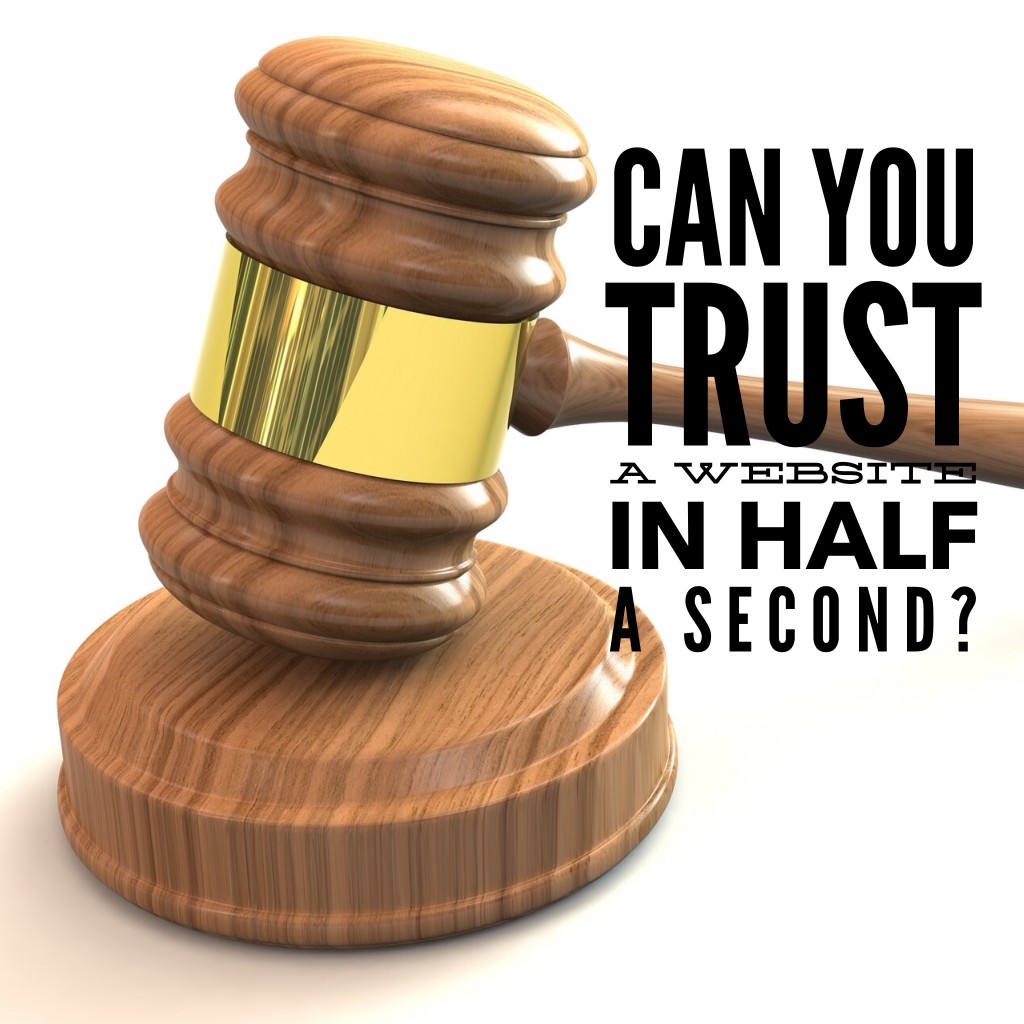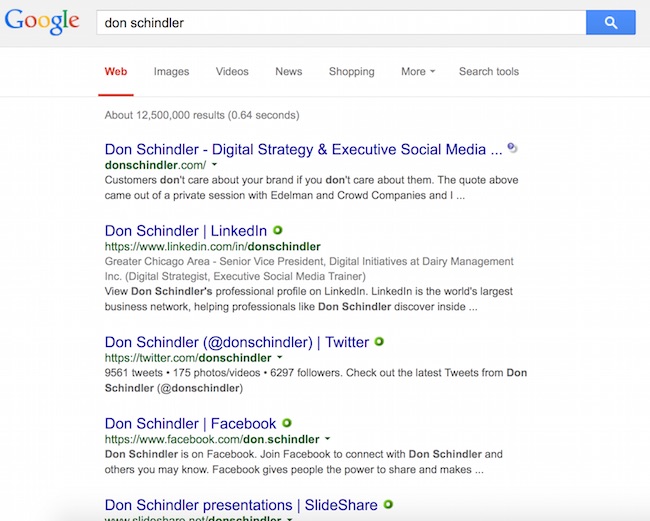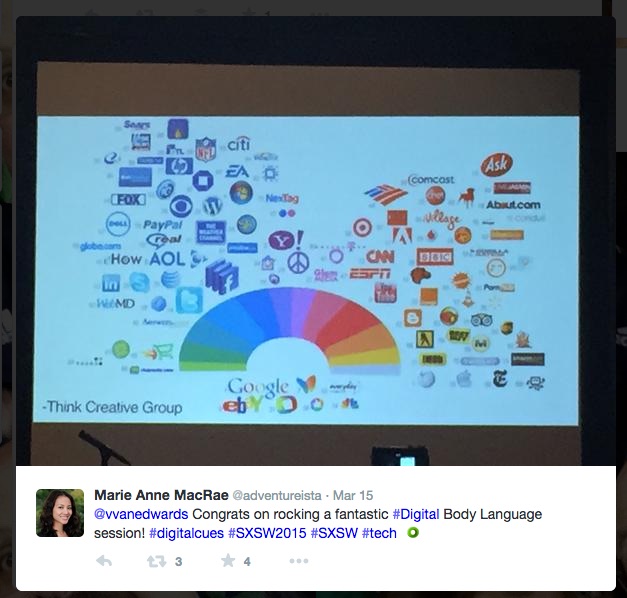
Our guts are pretty good indicators of trust. In fact, humans are hardwired to read a situation and come up with an impression in just 50 milliseconds. We get this “fight or flight” ability from our ancestors.
While not everything is a death threat, we use this ability without much thought to it.
So let’s talk about this “fight or flight” in reference to the internet.
When we are looking for a specific answer to a question, most of us trust Google (about 65% of searches start there) to deliver a website that will have the answer.
We scan the results quickly and decide to click on usually the first couple of links essentially our first impression.
Everything on the page (design, user interface, then content) will determine whether we believe what they say is true or we’ll bounce back to the results and click another link.
How you can adjust your website and online image to maximize your potential trust with a user was a SXSW workshop by psychologist and technologist, Vanessa Van Edwards.
Her workshop was called “Digital Body Language” and here’s what the description was:

“You have 0.05 seconds to make a good first impression online. In those 50 milliseconds you have to hook someone and convey your brand messaging, encourage clicks and build trust. Most important, this happens before a user reads any of your content, headlines or descriptions. You have to capture their attention with your website’s nonverbal cues or your digital body language.
Whether you run a business, work for a corporate brand or just want to better understand online human psychology this workshop is for you.
As a human behavior hacker, I’m going to show participants how to use the latest groundbreaking research to optimize advertisements, websites, social media profiles, online videos, print materials and emails. We will cover a wide array of online human behavior science such as:
*Using eye patterns to know how a user consumes your content.
*Using images congruent with your branding.
*The science of color psychology on customers and readers, and applying it to your brand’s online presence. Simple changes to your website like colors, text on buttons, people images, etc… can have a dramatic impact on its ability to convert customers and leave the best impression – in only 50 milliseconds.”
Her goals for the workshop were pretty simple.
- Be aware of what’s influencing YOU
- Take control of your cues.
- Supercharge your non-verbal branding.
Here are my notes from the class.
Vanessa Van Edwards has based her career on science-based application of 2400+ human behavior studies.
When people first meet you, they are sizing you up with many determining factors much like they do online digital presence.
These non-verbal cues are 12-13 times more powerful than the accompanying content.
So in other words, if you have all these awesome accomplishments on your LinkedIn profile but you have a bad head shot – the head shot will be more effective at trashing your reputation. I’ll give you points from her class on how to improve your head shots down below.
You must make sure your first impression does everything to build your trust indicators, your personal brand values, your credibility and your memorability so people will feel confident in making a decision in selecting you and your company.
Now what makes up your digital impression?
First, you do a Google search.
When people type in your name, what comes up?
Remember to logout of Google or use a different computer than what you normally use because search engines hold on to results so the results will be based on your history not what’s currently available.
Now what pops up?
Your websites, your images, your videos, etc…

All of these should leave a good impression of you – we’ll discuss more of how these images will look below.
Let’s dig into the links.
If your first link is your company website, there might be little you can do to control the environment that surrounds your head shot and biography.
But maybe you can. You can send this link to your website designer and they can make sure they have incorporated some of these tactics on your website.
When it comes to a digital presence of your company, the first impression is made by your website. On it, users will find your logo, the colors and fonts, photos and/or video, user interface like search box and navigation.
This is what users expect and if things are missing or in unusual places, this will question the credibility of your website – even before they read a bit of content.
So how do you know if your website is trusted?
There are several different ways to measure the effectiveness of your website and I recommend that you have goals set up in your Google Analytics to do this.
But if you don’t have them set up, you can go into your analytics and check out if users are clicking on the right links, if the Bounce Rate is too high (I like to stay lower than 50%) and Time on Page is to low (more than 2:30 minutes would be great).
Users should be clicking on your Call-to-Action – if you don’t have one then I honestly don’t know why you have a website. Most Call-To-Actions I set up are Buy Buttons or Sign-Up for Email buttons. Goals are based on the Thank You Purchase Page or the Thank You for Signing Up Page.
There are also some tools like trymyUI.com that can help you get feedback on what people think of your website.
And don’t get me wrong – text on the page is very, very important but it’s usually what people look at last after they quickly scanned the page for signs of trust like testimonials or third party logos.
Make sure the text you have is positive as this can lead to prime people to believe what they see on your page – negativity breeds mistrust of others but will affect your brand.
Now once they’ve decided to look over the page, what are some important elements that people will focus on?
People’s faces.
Yep, our brains are wired to look for the human face and then the patterns on the face (even when you physically can’t recall seeing the face you will have an impression about it).
Once we have recognized a face, we will quickly analyze their expression to see if they are friend or foe. And since we all study human faces all the time, we can easily pick out what they are feeling. In fact, there are a few expressions that are involuntary that we pick up right away and they can help or hurt your website’s credibility.
Vanessa went over three common expressions that influence trust and they are:
- Contempt – a smirk or raised angle smile will cause mistrust.
- Happiness – an honest smile will have crows feet in the eyes. Fake smiles don’t and can help just as much as contempt.
- Fear – if the user sees the upper whites of eyes (even if the face is smiling, it will seemed forced).
Check out the pictures on your website of people. Get rid of the fake stock photos and put in some genuine happy faces.
Next is the gaze.
Vanessa wanted us to know that there are particular ways that people look at other people as well as looking at websites so there are multiple ways you need to take gaze into account.
First is how people look at your website.
They use an F-pattern as first discovered by Jakob Nielsen in 2006 and it still works today.
People scan the site, looking for normal patterns.
Logo, navigation, search box, social then down the page to images and content, then they quickly scroll down the page.
Your crucial information should be placed within this pattern to make sure it is found. Many times I see Call-To-Action buttons or boxes at the very bottom of the page or in an unusual spot. It’s ok to be unusual if you are going to draw attention to the button with color or an image.
But there’s another gaze that we pay attention to.
The gaze of the people on the website.
You can direct people to different places on the website by simply aiming the gaze of the person on the page. People will automatically look in the direction of the person on the page – make sure your call to action is in that gaze.
Another great way to make a good digital impression is to have video on the page or within your search results.
Video is powerful communication vehicle and people tend to watch videos more than anything else online (notice the growing popularity of Facebook videos and YouTube).
But to have a good video that can earn you trust, you must pay attention to the psychological best practices.
Van Edwards just released a great study on the best and worst TED talks. They analyzed over thousands of hours of TED talks to find out the commonalities of these speakers and have come up with some remarkable studies.
Going back to our gut reaction, we decide within the first seven seconds whether we trust the subject of the video. Seven seconds.
If you don’t get them to trust you in the first seven seconds, you won’t get them to trust you the entire talk.
So what are the best practices of the best TED talks?
- Hands – the study found that the use of your hands in a presentation determined success and trust. 465 > 272 best to worst. If you talk with your hands in videos, then keep doing it. If you don’t, you need to start using them. Things to do with your hands are pointing out growth, counting numbers (1, 2, 3) and personal passion (touch your heart).
- Vocal Variety – You have to change your tone. Let it flow with your emotion and definitely change your cadence to keep the audience engaged. They never know where you are going next.
- Smile – Add jokes, tell stories you can smile at even if the topic is serious and use that smile. The best speakers smiled 36.25 sec vs. 9.15 sec of the worst ones.
From her blog post – you can also add Enthusiasm (people liked speakers even with the sound off – so gestures and constant movement), and not using scripts (makes people too stiff and like they don’t know what they are talking about – politicians should take note).
Next let’s talk color.
Now if you are like me, you might have picked the color of your logo or your website based on your favorite colors. But remember you are trying to make an impression on someone so colors and font choices mean a great deal to the user – not just what you like.
Research reveals people base between 62-90% of their assessment on color alone.
So what do certain colors mean to the user?
- Blue – loyalty, stability, tranquil
- Red – passion, aggression, sex, metabolism
- yellow – happy, optimism, youth
- green – healing, success, hope
- Black – power, mystery, professional
- Purple – royalty, spirit, luxury
- Brown – stable, natural, reliability
- Orange – energy, fun, warmth
- White – purity, cleanliness, innocence
- Gray – neutral, practical, quiet
What you need to do is limit or eliminate off brand colors, confusing color cues, or purposeless colors. Everything is intentional whether you mean to do it or not.
Wow, are we ever going to get to the content on the page. Yep, now we are.
When it comes to the content, people are going to be looking for authenticity cues. That you are who you say you are.
Now how do you do this?
Authenticity comes from personal stories embedded within your profession information. The “WHY” you do what you do is just as important as they stuff you do. It needs to match up.
But you need to make sure you are eliminating grammar errors (tough for me), spelling errors (even worse) and anything vague that could be a lie so be specific.
You can add social proof to build trust with testimonials, reviews and certifications as well as recognized logos.
Then she spoke about confidence cues.
She said that when we meet someone new we are always sizing them up.
It’s our Alpha thought – are they awesome or am I?
Power body language (body position) has a halo effect – use more space and you will effect more than just you.
If you want people to think you have more confidence then use your body language in ways that are expansive. You are staking claim over territory, keep your head high, arms wide, shoulders back, chest open. The more space you use, the higher people perceive your confidence.
People perceive low confidence as your body is contracted, less space, the more your head is down or bowed and shoulders rolled. Hey, do you know what we look like when we are looking at our phones. You got it – low confidence.
Again, how do we take this to your website and your online presence?
Let’s talk about your head shots – a good headshot according to Vanessa was one that is viewed from below, aim your torso and toes toward the person and eyes gazing at the camera – you will look more trustworthy, open-minded and sympathetic.
If you need to look helpless and get sympathy, be viewed from above and don’t meet the gaze of the camera.
She did a great job in explaining how cereal boxes do this to kids (and adults) with their branding and mascots.
Finally, Vanessa spoke about capturing attention.
She spoke about a spectrum of attraction that users are on when they visit your website or online presence.
When you have too much or too little, you can really hamper people from making decisions.
Sounds and animations (like gifs and auto start videos) can grab attention, but too much and they annoy or distract people from the surrounding content.
Too few or too many choices will also cause a user to pause when making a decision.
There’s always an issue with dropping too many links in an article. You have to find the right balance so you should always be testing.
They did find out what kind of things and buttons people like clicking on. Start Here, Entry Level Products, Freeiums, etc…
We started to run out of time toward the end but I’m telling you it was one of the better workshops I attended at SXSW and I was very impressed with amount of information.




Leave a Reply